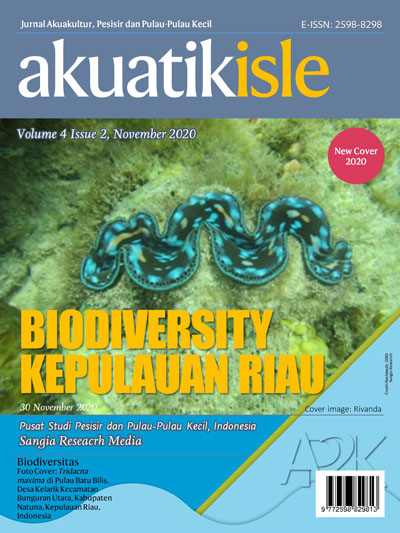Akuatikisle: Jurnal Akuakultur, Pesisir dan Pulau-Pulau Kecil
Full Length Article
The level of damage to the mangrove ecosystem in the Sei Jang Estuary Area, Bukit Bestari District, Tanjungpinang City, Riau Islands, Indonesia
Tingkat kerusakan ekosistem mangrove di Kawasan Estuari Sei Jang Kecamatan Bukit Bestari Kota Tanjungpinang, Kepulauan Riau, Indonesia
Highlights
Generate NLP AI by Wizdam ID.
Abstract
Penelitian mengenai tingkat kerusakan ekosistem mangrove telah dilakukan di Kawasan Estuari Sei Jang. Tujuan dari penelitian ini untuk mengetahui jenis-jenis mangrove, kerapatan dan persentase tutupan kanopi mangrove, serta tingkat kerusakan ekosistem mangrove di Kawasan Estuari Sei Jang Kota Tanjungpinang. Penelitian dilaksanakan pada bulan Maret 2019. Penentuan titik lokasi penelitian menggunakan metode purposive sampling sebanyak 3 stasiun dan menggunakan transek 10 x 10 m untuk kerapatan dan persentase tutupan kanopi mangrove. Hasil penelitian ditemukan empat jenis mangrove yaitu Bruguiera gymnorhiza, Rhizophora apiculata, Rhizophora mucronata, dan Ceriops tagal dengan nilai kerapatan (1.033-1.367 individu/ha) dan Persentase tutupan kanopi mangrove dengan nilai (61,55-78,41%). Untuk tingkat keruksan pada Stasiun I dan III terkategori (baik) dan Stasiun II terkategori (Rusak).
Abstract
Research on the level of damage to mangrove ecosystems has been carried out in Estuarine Area Sei Jang. The purpose of this study was to determine the types of mangroves, the density and percentage of mangrove canopy cover, and the level of damage to mangrove ecosystems in the Sei Jang Estuary Area of Tanjung Pinang City. This research was conducted in March 2019. Determination of the research location using a purposive sampling method of 3 stations and using a 10 x 10 m transect for the density and percentage of mangrove canopy cover. The results found four types of mangroves namely Bruguiera gymnorhiza, Rhizophora apiculata, Rhizophora mucronata, and Ceriops tagal with density values (1.033-1.367 individu/ha) and the percentage of mangrove canopy cover with values (61.55-78.41%). For the level of damage at Station I and III are categorized (good) and Station II is categorized (Damaged).
Keywords
Introduction
Section snippets
Material and Methods
Materials and methods from the full-text PDF of this article cannot be displayed.
Results
Results from the full-text PDF of this article cannot be displayed.
Discussion
Discussion from the full-text PDF of this article cannot be displayed.
Conclusions
Conclusions from the full-text PDF of this article cannot be displayed.
Acknowledgment
Acknowledgment from the full-text PDF of this article cannot be displayed.
Competing interest
The authors declare that they have no known competing financial interests or personal relationships that could have appeared to influence the work reported in this paper.
Conflict of interest
The authors declare that the research was conducted in the absence of any commercial or financial relationships that could be construed as a potential conflict of interest.
Ethical approval acknowledgements
No ethical approval required for this article. All procedures followed were in accordance with the ethical standards of the responsible committee on human experimentation (institutional and national) and with the Helsinki Declaration of 1975, as revised in 2008 (5)
Data availability
All the data have been provided via Supplementary files. Any further information can be requested from the corresponding author via email upon reasonable request.
Appendix. Supplementary materials
Supplementary File 1: Tingkat Kerusakan Ekosistem Mangrove Di Kawasan Estuari Sei Jang Kecamatan Bukit Bestari Kota Tanjungpinang Provinsi Kepulauan Riau (Research Results)
Declarations information
License and permission
 This work is licensed under a Creative Commons Attribution-ShareAlike 4.0 International License (https://creativecommons.org/licenses/by-sa/4.0), which permits use, sharing, adaptation, distribution and reproduction in any medium or format, as long as you give appropriate credit to the original author(s) and the source, provide a link to the Creative Commons licence, and indicate if changes were made. The images or other third party material in this article are included in the article's Creative Commons licence, unless indicated otherwise in a credit line to the material. If material is not included in the article's Creative Commons licence and your intended use is not permitted by statutory regulation or exceeds the permitted use, you will need to obtain permission directly from the copyright holder.
This work is licensed under a Creative Commons Attribution-ShareAlike 4.0 International License (https://creativecommons.org/licenses/by-sa/4.0), which permits use, sharing, adaptation, distribution and reproduction in any medium or format, as long as you give appropriate credit to the original author(s) and the source, provide a link to the Creative Commons licence, and indicate if changes were made. The images or other third party material in this article are included in the article's Creative Commons licence, unless indicated otherwise in a credit line to the material. If material is not included in the article's Creative Commons licence and your intended use is not permitted by statutory regulation or exceeds the permitted use, you will need to obtain permission directly from the copyright holder.
Publisher's Note
Sangia Publishing remains neutral with regard to jurisdictional claims in published maps and institutional affiliations.
Bibliographic Information
Cite this article as:
-
Submitted
13 January 2020 -
Revised
22 May 2020 -
Accepted
10 June 2020 -
Published
17 October 2020 -
Version of record
26 May 2023 -
Issue date
30 November 2020
-
Academic subject
Fisheries; Fisheries Science
Copyright
Kepulauan Riau has enormous potential for marine resources. Marine biological resources ranging from mangroves, fish, shellfish, coral, and much more. However, behind such great wealth, there are also management challenges. Susiana and colleagues inventory potential resources of Tridacnidae clams in Riau Islands, Indonesia. See Rivanda et al.
Copyright © 2020 Hazri Rizaldi, Febrianti Lestari, & Susiana Susiana. Sangia Research Media and Publishing. Production and hosting by Sangia (SRM™).  This work is licensed under a Creative Commons Attribution-ShareAlike 4.0 International License.
This work is licensed under a Creative Commons Attribution-ShareAlike 4.0 International License.
Disclaimer: All claims expressed in this article are solely those of the authors and do not necessarily represent those of their affiliated organizations, or those of the publisher, the editors and the reviewers. Any product that may be evaluated in this article or claim that may be made by its manufacturer is not guaranteed or endorsed by the publisher.
Comments on this article
By submitting a comment you agree to abide by our Terms and Community Guidelines. If you find something abusive or that does not comply with our terms or guidelines please flag it as inappropriate.




